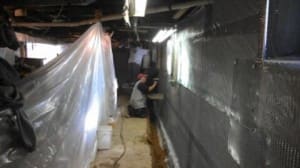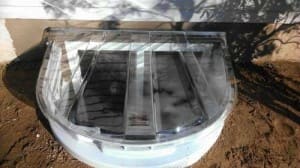
Problem: Wet Basement or Water Seepage
Basement leaks are the result of Mother Nature battling basement construction. Nature is a powerful force, and basements aren’t originally built to be as waterproof as you might hope. The result is that many homeowners need to invest in professional basement waterproofing eventually.
Cause
Two basic natural principles are terrible for basements: erosion and water flow. Erosion in nature turns rock into sand and crushes mountains into gravel. It is trying to do the exact same thing to your house all the time, so of course maintenance is going to be involved.
Water flow also presents problems for homeowners. Thanks to gravity, water flows down into the ground. Before your basement was taking up a giant hollow block of space in the earth, there was soil and clay there. Once the building process compresses the soil below and around your home, there is only one place for water to go: your basement. Water will often build up and create hydrostatic pressure around your home, eventually creating fissures and forcing its way inside.
Unfortunately, homes aren’t exactly built to be waterproof. Your home likely sits on a concrete footing, which is essentially a big block of concrete set in a wooden rectangle or square. On top of the footing lies the foundation of your home, and on top of the foundations sits your basement floor. Each layer is made of concrete, and there is a small amount of space between each of these layers. The small cracks between the layers are an invitation for water to invade, create cracks, and eventually leak into and flood your basement.
Solution
It takes quite a bit of human ingenuity to defeat Mother Nature. Luckily, human ingenuity is pretty powerful, and we’ve figured out a way to keep moisture out. A combination of drainage and sealing techniques on the interior and/or exterior of your home are widely considered the best method of waterproofing a basement. Drainage directs water out and away from your house, while coatings provide a barrier that prevents even small amounts of moisture from collecting. These methods provide just the right touch your basement nice and dry, no matter how hard Mother Nature may work to get in.
Need Help with Basement Water Seepage?
Interior Water Management
A flooded or leaky basement not only robs you of valuable living and storage space, it can result in serious foundation damage. Tackling the problem from the inside first takes care of the emergency and restores your basement to a dry, usable state. Interior water management is surprisingly low-cost and is often the only solution customers need.
Drainage: A drainage system is essential for any basement experiencing significant leaking or flooding. It effectively directs water out of your basement and away from your home. It. Pipes under your floor collect the water and take it to a sump pump or French drain. The pump or drain then pushes the water far, far away from your house.

Coatings: Indoor sealing works well in conjunction with drainage systems to keep the smallest amounts of water out of the home. Coating walls with a waterproof substance prevents water from entering through even microscopic openings, working wonders to keep dampness out.
Exterior Water Management System

Drainage: An indoor drainage system can get water out of your home and pump it further away, but it does not prevent water outside of your home from putting pressure on your walls. This can cause cracks and leaks in your basement. Creating a drainage system to stop water from collecting around your house will stop this from happening. A variety of techniques, from installing outdoor pumps to digging trenches, are effective for lessening the pressure and halting the issue in its tracks.
Sealing: Sealing exterior foundation walls with a waterproof coating can stop water from ever getting into your house in the first place. Exterior materials can be sprayed or covered with a non-porous substance to augment exterior drainage systems.
